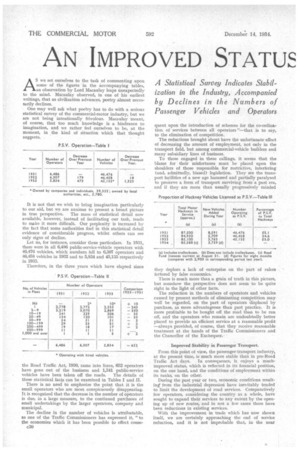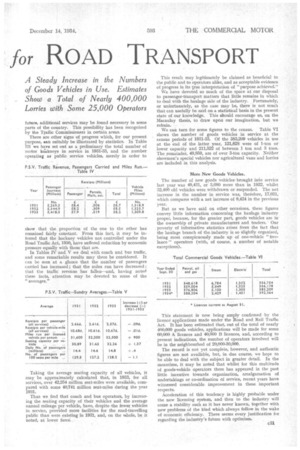AN IMPROVED STATUS
Page 84

Page 85

If you've noticed an error in this article please click here to report it so we can fix it.
for ROAD TRANSPORT AS we set ourselves to the task of commenting upon some of the figures in the accompanying tables, an observation by Lord Macaulay leaps unexpectedly to the mind. Macaulay observed, in one of his earliest writings, that as civilization advances, poetry almost necessarily declines.
• One may well ask what poetry has to do with a serious statistical survey of the commercial-motor industry, but we are not being intentionally frivolous. Macaulay meant, of course, that too much knowledge is a hindrance to imagination, and we rather feel ourselves to be, at the moment, in the kind of situation which that thought suggests.
It is not that we wish to bring imagination particularly to our aid, but we are anxious to present a broad picture in true perspective. The mass of statistical detail now available, however, instead of facilitating our task, tends to make it more difficult. Our perplexity is increased by the fact that some authorities find in this statistical detail evidence of considerable progress, whilst others can see only signs of decline.
Let us, for instance, consider these particulars. In 1931, there were in all 6,486 public-service-vehicle operators with 46,476 vehicles, which numbers fell to 6,307 operators and 46,458 vehicles in 1932 and to 5,834 and 45,135 respectively in 1933.
Therefore, in the three years which have elapsed since the Road Traffic Act, 1930, came into force, 652 operators have gone out of the business and 1,341 public-service vehicles have been taken off the roads. The details of these statistical facts can be examined in Tables I and IL There is no need to emphasize the point that it is the small operators who are most conspicuously disappearing. It is recognized that the decrease in the number of operators is due, in a large measure, to the continued purchases of small undertakings by the larger operators, company and municipal.
The decline in the number of vehicles is attributable, as one of the Traffic Commissioners has expressed it, "to the economies which it has been possible to effect come
c30 quent upon the introduction of schemes for the co-ordination of services between all operators "-that is to say, to the elimination of competition.
The reductions brought about have the unfortunate effect of decreasing the amount of employment, not only in the transport field, but among commercial-vehicle builders and many subsidiary lines of business.
To those engaged in these callings, it seems that the blame for their misfortunes must be placed upon the shoulders of those responsible for restrictive, interfering (and, admittedly, biased) legislation. They see the transport facilities of a new age harassed and partially paralysed to preserve a form of transport surviving from a past era, and if they are more than usually progressively minded they deplore a lack of enterprise on the part of rulers fettered by false economics.
There is much more than a grain of truth in this picture, but somehow the perspective does not seem to be quite right in the light of other facts.
The reduction in the numbers of operators and vehicles caused by present methods of eliminating competition may well be regarded, on the part of operators displaced by purchase, as more advantageous than past practice. It is more profitable to be bought off the road than to be run off, and the operators who remain are undoubtedly better placed to provide an efficient service at a reasonable profit -always provided, of course, that they receive reasonable treatment at the hands of the Traffic Commissioners and the Chancellor of the Exchequer.
Improved Stability in Passenger Transport.
From this point of view, the passenger-transport industry, at the present time, is much more stable than in pre-Road
Traffic Act days. In consequence, it enjoys a 'muchimproved status, which is reflected in its financial position, on the one hand, and the conditions of employment within its ranks, on the other.
During the past year or two, economic conditions resulting' from the industrial depression have inevitably tended to limit the development of road services. Comparatively few operators, considering the country as a whole, have sought to expand their services to any extent by the opening up of new routes, and in not a few cases there have been reductions in existing services. "
With the improvement in trade which has now shown itself, we are certainly approaching the end of service reduction, and it is not improbable that, inthe near future, additional services may be found necessary in some parts of the country. This possibility has been recognized by the Traffic Commissioners in certain areas.
There are other signs of progress which, for our present purpose, earl suitably be illustrated by statistics. In Table IT f we have set out as a preliminary the total number of motor halkneys in service in 1931-33, and the number operating as public service vehicles, merely in order to show that the proportion of the one to the other has remained fairly constant. From this fact, it may be inferred that the hackney vehicles not controlled under the Road Traffic Act, 1930, have suffered reduction by economic pressure equally with those that are.
In Tables EV and V we deal with coach and bus traffic, and some remarkable results may there be considered. It can be seen at a glance that the number of passengers carried has increased ; that the miles run have decreased : that the traffic revenue has fallen-and, having noted these facts, attention may be devoted to some of the "averages."
Taking the average seating capacity of all vehicles, it may be approximately calculated that, in 1933, for all services, over 42,254 million seat-miles were available, compared with some 40,741 million seat-miles during the year 1931.
Thus we find that coach and bus operators, by increasjug the seating capacity of their vehicles and the average annual mileage per vehicle, have, despite the fewer vehicles in service, provided more facilities for the road-travelling public than were existing in 1931, and, on the whole, be it noted, at lower fares:
This result may legitimately be claimed as beneficial to the public and to operators alike, and as acceptable evidence of progress in its true interpretation of "purpose achieved."
We have devoted so much of the space at our disposal to passenger-transport matters that little remains in which to deal with the haulage side of the industry. Fortunately, or unfortunately, as the case may be, there is not much that can usefully be said on a statistical basis in the present state of our knowledge. This should encourage us, on the Macaulay thesis, to draw upon our imagination, but we refrain.
We can turn for some figures to the census. Table VI shows the number of goods vehicles in service at the census periods of 1931-33. Of the 383,209 vehicles in use at the end of the latter year, 121,828 were of 1-ton or lower capacity and 211,522 of between 1 ton and 3 tons. The remainder, 49,859, are of over 3-ton capacity. Neither showmen's special vehicles nor agricultural vans and lorries are included in this analysis.
More New Goods Vehicles.
The number of new goods vehicles-brought into service last year was 49,431, or 3,680 more than in 1932, whilst 32,400 old vehicles were withdrawn or suspended. The net increase in the number in service was therefore, 17,031, which compares with a net increase of 9:424 in the previous year.
But as we have said on other occasions, these figures convey little information concerning the haulage industry proper, because, for the greater part, goods vehicles are inthe ownership of private manufacturers and traders. Our poverty of informative statistics arises from the fact that the haulage branch of the industry is so slightly organized, being most conspicuously made up of one-vehicle " freelance " operators (with, of course, a number of notable exceptions).
This statement is now being amply confirmed by the licence applications made under the Road and Rail Traffic Act. It has been estimated that, out of the total of nearly 400,000 goods vehicles, applications will be made for some 60,000 A licences and 40,000 B licences, and, according to present indications, the number of operators involved will be in the neighbourhod of 20,000-30,000.
The record is not yet complete, however, and authentic figures are not available, but, in due course, we hope to be able to deal with the subject in greater detail. In the meantime, it may be noted that whilst for this multitude of goods-vehicle operators there has appeared in the past little incentive towards organization, amalgamation of undertakings or co-ordination of service, recent years have witnessed considerable improvement in these important respects.
Acceleration of this tendency is highly probable under the new licensing system, and then to the industry will come a stability such as it has never known, together with new problems of the kind which always follow in the wake of economic efficiency. There seems every justification for regarding the industry's future with optimism.




































































































































































